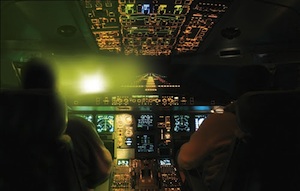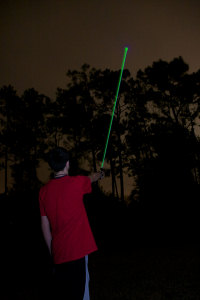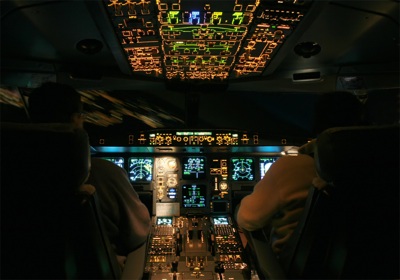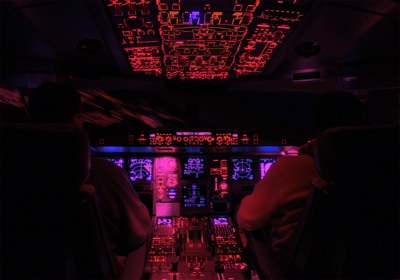Home
A comprehensive resource for safe and responsible laser use

Frequently Asked Questions for doubters
For persons doubting that lasers are a problem to pilots
Some people have a hard time understanding how the seemingly thin, dim beam of a laser can be a significant problem to pilots. This FAQ addresses some of the issues raised by doubters. For more general questions, see our general FAQ about pointer safety.
If you have a question not answered by either FAQ, please contact us using the link at the very bottom of this page.
LASER POINTER HAZARDS- Why is a laser pointer hazardous to aircraft?
- What are some pilot reactions to laser flashes?
- EVIDENCE THAT LASERS MAKE IT HARD TO FLY
- Are the photos of laser effects realistic?
- Are the animations of laser effects realistic?
- I still don't believe the photos and animations.
- But I can drive at night despite oncoming headlights.
- What about non-laser sources like searchlights? Are they a hazard to aviation?
- PILOT ATTITUDES
- Why are pilots bothered by laser light that doesn't bother me?
- Aren't pilots overreacting?
- How could a flash of light cause an airplane to crash?
- SAFE USE IN THE NIGHT SKY
- Why should laser pointers never be aimed at aircraft?
- But isn't it legal to illuminate aircraft if the laser power is low enough?
- Doesn't the beam of a laser pointer aimed outside seem to end?
- ANTI-LASER CONTROL MEASURES
- Would it work to make the windshield mirrored, like sunglasses?
- Why don't we just require pilots to wear anti-laser glasses?
-
LASER POINTER HAZARDS -
Why is a laser pointer hazardous to aircraft?We see three statements constantly repeated on Internet message boards and on comments to news stories about incidents. People write (inaccurately) that 1) the dot from a laser pointer is small, 2) that it is hard to hit or keep it on an aircraft, and 3) that an aircraft's windows are facing up and thus away from the ground. While there is some truth in these statements, the fact is that laser light can all too easily be a distraction or obstruction to pilot vision:
- Beam size: A laser's beam spreads out. At long ranges the beam can be many inches or even feet in diameter. When laser light hits an aircraft's windscreen, tiny scratches and dirt spread the light out even more, causing glare around the beam center. The result is that pilots do not see a small dot, they see a large glow similar to being in a flashlight or searchlight beam. It can be difficult or impossible to see through the glow. You can see this in photos here and here.
- Beam flashes: Yes, it is hard to hand-hold a laser on a moving target that is far away. That's why in most laser pointer incidents, pilots don't see a steady light on them. Instead, they see one or more flashes. The flashes are distracting at best, and at worse, they can be bright enough to cause temporary flashblindness. This is similar to having a camera flash (or flashes) go off in your face. Even if the beam is just waved around the aircraft so it does not directly enter the windscreen, it can be distracting or worrisome to see a waving beam aimed towards one's aircraft. (See the video here, where the laser only occasionally hits the helicopter but the beam still is a distraction.)
- Window orientation: If a pilot can see the ground outside his or her window, then obviously the pilot could be directly hit by a laser aimed from anywhere within that view. Plus, even if the pilot's eyes are not in a direct line with the laser source, the laser beam could light up other areas in the cockpit such as the ceiling, causing a distraction. This is because, as discussed above, the light at altitude creates a large glow on the windscreen.
So, when thinking about risks from laser light, don't think just about airplanes flying at 35,000 feet.. Think about the times airplanes are at most risk: during takeoffs and especially during landings. And think about helicopters, which fly low and slow and have large bubble canopies. That's why almost all laser pointer aircraft incidents involve airplane landings, takeoffs, and helicopter operations.
The sheer number of laser pointer incident reports (almost 26 every night in the U.S. as of 2022) should be enough to convince anyone that pilots really are being hit and distracted by laser light. If still not convinced, you may also want to see the FAQ questions below, "How could a flash of light cause an airplane to crash" and "Why are pilots bothered by laser light that doesn't bother me?", and take a look at the 2004 FAA simulator study results and the 2009 searchlight-laser comparison. -
What are some pilot reactions to laser flashes?These are some representative reports from pilots who had eye effects or injuries from laser illuminations. All of these are from 2016 FAA reports. Ask yourself: If you or a loved one was flying, would you want this to happen to the pilot?
• “At 400 feet AGL [above ground level] a green laser beam directly contacted the pilot’s eyes 2 or 3 times. The duration was ‘extremely brief.’ The pilot advised that it was similar to being temporarily blinded by looking at the sun. He did a go-around and did not land at the airport. His vision has since recovered.”
• “Strong but brief blue laser illumination. Report possible eye injury to pilot. Will update when more is known.”
• “Laser from the south. Pilot struck in left eye. Experienced momentary double vision, but appeared to be recovered.”
• “Green laser illumination event approximately 1 mile east. Pilot reported pain in his left eye.”
• “Flashing green laser from the south. Captain reported injury to right eye. Advised ATC he was seeking medical attention.”
• “Illuminated by a very powerful green laser. Pilot was incapacitated. He was seeing dots and could not adjust his vision even after 10 minutes.”
• “Student pilot was disabled from green laser illumination as he departed. Instructor had to take over control of the aircraft.”
• “Green laser illumination lasting roughly 2 ½ minutes about 5 miles from the aircraft. The first officer reported a lasting glare in his eyes when he closed his eyelids after the event. He advised he would be seeking medical attention.”
-
EVIDENCE THAT LASERS MAKE IT HARD TO FLY
-
Are the photos of laser effects realistic?Yes, photos from the FAA such as the 2003 simulator study pictures here, and the 2010 photo-illustration below, give a good idea of what a laser incident looks like at the moment of peak exposure.

A stock photo of an Airbus A330 at Zurich airport has had a runway image and a laser glow image added via Photoshop. Despite the fact that this is not a photo of an actual laser illumination, the photo-illustration is "close enough" to what a real laser illumination would look like.
In 2003 the FAA conducted a study where they set up a laser in an FAA Boeing 727 flight simulator. It had a windscreen that had been removed from service, so it had typical scratches and weathering. The reason for using a simulator was to be able to accurately measure the beam irradiance.
Although photos such as the one above were taken in a simulator, it is inaccurate to call them a "simulation". They are real lasers in a real cockpit with a real windscreen. They simulate a laser illumination incident in part because an actual flight is expensive to set up, and because for the purposes of the study, they needed to have precise measurements of the laser illumination.
Details about the four 2003 simulator photos are here.
If you compare the FAA photos with a video of an actual in-flight incident, you will see that the photos are remarkably similar to the video, during the moment of peak exposure. There have been a number of in-flight tests by researchers and the Air Force; they have found similar results. -
Are the animations of laser effects realistic?An unfortunate problem with still photos of laser effects on cockpits, is that it gives an impression of a continuous light.
However, in a typical illumination event, the laser is not a continuous "blob" of light, but instead flashes across the cockpit. This is because it is so hard to keep a hand-held laser steady on a moving target. In most incident reports on our aviation-incident news page, pilots are hit with only a few direct flashes. (Even a beam that does not enter the windscreen can still be distracting and worrisome to a pilot, of course.)
For this reason, we animated the 2003 FAA simulator pictures so they looked more like flashes. The animations can be seen here; a description of how the animation was done is here.
To judge for yourself if the animations are realistic, compare them to videos of actual in-flight laser hits on helicopters. A list of some videos is here; you may have to scroll to find videos specifically taken in-flight. You should see that the animations are reasonable depictions of a flash event.
Additional details: The animated flashes last a bit longer than a real flash. In the FAA simulator study, pilots were exposed to 1-second flashes. However, calculations by LaserPointerSafety.com show that an actual flash might be closer to 1/50 second. Also, if you look at a video of actual in-flight laser hits, often the peak exposures only last for a frame or two (e.g., 1/30 or 1/15 second). The animations therefore "split the difference" by making the flashes last 1/2 second (25/50 sec.) The larger and most important point, that pilots can be distracted or flashblinded by brief flashes of light, is adequately illustrated by the animations even if a real-world flash is shorter or longer.
-
I still don't believe the photos and animations.We feel that the photos, animations and videos presented here at LaserPointerSafety.com give an accurate impression of what a laser illumination looks like to a pilot.
But if you still have doubts, you can run your own tests. Have a friend with a laser pointer aim it at you, while you are some distance away. You should run the test while sitting behind a car windshield, which somewhat simulates an aircraft's windscreen. Pretend you don't know the flash is coming, and that you are piloting an airliner with hundreds of people onboard.
How far away should you be? First, you should be beyond the laser's hazard distance ("NOHD"). See this chart for some representative powers and distances. Keep in mind that some laser pointers are mislabeled and so they may be significantly more powerful than the label indicates. Then, choose a distance to correspond with the altitude you're interested in -- a few hundred feet to represent someone close to a runway or a hovering helicopter, or a few thousand feet to represent an airplane at higher altitude.
IMPORTANT: LaserPointerSafety.com does not know anything about your laser and cannot be responsible for any injuries or other consequences should you do this test. At the very least, you should turn away from the laser and first look at its size and brightness on surrounding objects, before deciding whether to turn back into the beam and face it head-on.
Frankly, it is easier to assume that the FAA and other parties have already determined via studies like this and this, the common-sense notion that unexpected bright light is distracting at best, and at worse can cause flashblindness and afterimages. -
But I can drive at night despite oncoming headlights.Driving a car at night, and landing an airliner are two very different things.
At night, you expect oncoming headlights. Most cars' low-beams are not aimed at your face. A misaligned headlight, or "brights" will dazzle you more. It becomes harder to see the road, and there may be some time to recover full night vision. This more direct and bright hit is more representative of what a pilot might see.
Don't forget that pilots are not expecting bright lights during landings. -
What about non-laser sources like searchlights? Are they a hazard to aviation?Tests conducted by Dutch researchers have shown that searchlights are much less distracting than lasers. For example, the beam from a truck-mounted searchlight did not significantly distract or impair a helicopter pilot flying 200 to 500 meters away. In contrast, the beam from a 3.5mW laser pointer purchased at a RadioShack store caused distraction, startle, glare and even some flashblindness/afterimages at the same distance.
Occasionally, searchlights are mistaken for laser lights. One such incident is reported here. -
PILOT ATTITUDES
-
Why are pilots bothered by laser light that doesn't bother me?Pilots are not laser enthusiasts. They are flying an aircraft and are dark-adapted; they do not expect or want bright lights flashed in their face. This is especially true during times they have to concentrate, such as takeoff, landing, and any out-of-the-ordinary situations. A bright flash seconds from a critical operation is not a good situation. This is why you should NEVER aim a laser at an aircraft.
-
Aren't pilots overreacting?Pilots have greater responsibility for safety than most people. So they get more worried when there is something out of the ordinary and potentially hazardous, like an unexpected bright light. Also, their job relies on their eyesight. If it is impaired in any way, they can be temporarily or permanently removed from flight duties. Finally, they rightly feel that waving a laser around in the sky is much less important to the world than transporting passengers and cargo. Their first inclination would be to simply ban consumer lasers, in the hopes of reducing the many incidents that occur (almost 26 incidents per night, on average, in the U.S. during 2022).
On the other hand, pilots should keep in mind that this is just light. It does not damage or impede the aircraft. If pilots know how to recognize, avoid and recover from an incident, they can handle even very bright laser light. LaserPointerSafety.com has called for the FAA, airlines and pilot organizations to support pilot education. This will help in extreme cases, where a laser incident might occur during an emergency or where persons with evil intent might deliberately target aircraft.
Pilots should not have to put up lasers being aimed at them. But if through an accident or deliberateness an incident does occur, then ultimately it is the pilot's responsibility to know how to successfully handle such a bright light event. The pilot is the last link in the safety chain.
-
How could a flash of light cause an airplane to crash?In most cases, a laser flash is manageable by pilots. However, aircraft accidents usually occur due to a string of events, any one of which would normally be manageable but as a group lead to disaster. If during a tricky landing or an emergency the pilots are distracted or flashblinded, the laser flash could be the "straw that broke the camel's back".
For example, think about US Airways flight 1549, the one that landed safely in the Hudson River in January 2009. The pilot showed great skill. But imagine if someone on land saw the plane coming in and used his laser pen to point it out to a friend. If the pilots were flashblinded or even just distracted by laser light, there could have been a very different outcome.
Information for pilots on how to manage a laser flash is here.
-
SAFE USE IN THE NIGHT SKY
-
Why should laser pointers never be aimed at aircraft?It is bad for pilots and passengers, it is bad for you (arrest, trial, jail) and it could lead to bans on laser pointers. See this page for more details.
-
But isn't it legal to illuminate aircraft if the laser power is low enough?People have been arrested and brought to trial for hitting an aircraft with laser light that is theoretically below FAA-specified power levels. A California man was jailed for two years, for using a legal 3.3 milliwatt laser pointer on an aircraft. He was jailed even though the irradiance may theoretically have been OK according to the FAA.
A partial list of people who have been fined and jailed is available here.
Any deliberate targeting of an aircraft is taken very seriously by pilots and authorities. They don't have power meters. All they know is that someone aimed a laser at them -- and it could even be a laser sight on a gun. Therefore, if found, you will almost certainly be arrested.
In the U.S. a federal law introduced in 2012 makes it illegal to “knowingly aim the beam of a laser pointer at an aircraft … or at the flight path of such an aircraft…” Some states have similar laws. These laws do not make any exception for the power of the laser. -
Doesn't the beam of a laser pointer aimed outside seem to end?If you aim a laser pointer into a clear nighttime sky, it can appear that the beam ends after a certain point, as shown in this unretouched photo:

This is a visual effect similar to an optical illusion. (The illusion is explained on this page.) Unfortunately, many people do not realize the hazard. They aim at aircraft, mistakenly thinking the beam only goes a short distance and then (somehow) stops.
For example, in February 2011 a 14-year-old boy was arrested for illuminating an aircraft on approach to Los Angeles International Airport. He told police that he thought the beam “would not go up to the height of the aircraft.”
This is a dangerous misconception. The laser's light does not suddenly stop in mid-air. It may pass into clearer air, which does not scatter much light back to the viewer. But the light definitely continues on.
Instead of hundreds of feet, the laser can be a distraction at a distance of many miles. This is yet another reason why you should NEVER aim a laser at or near an aircraft: If you can see the aircraft or its lights, then it can certainly see your laser -- and be visually distracted or flashblinded by it. -
ANTI-LASER CONTROL MEASURES
-
Would it work to make the windshield mirrored, like sunglasses?No, a mirrored aircraft windscreen, or helicopter "bubble", would not be practical. First, there are cost and durability issues regarding the mirror coating. But more importantly, a mirrored coating would reflect ALL light going through it. If it dims a laser beam by 90%, so it can be safely viewed without glare, it also dims all other lights by 90%. This includes airport runway lights, guide beacons, warning strobes etc. These are already dim to begin with -- it would be like landing an airplane with dark sunglasses on.
However, it may be possible to put a film on aircraft windscreens which reflects laser light but transmits other light. Such a film would need to have a narrow bandpass meaning that it reflects only certain laser wavelengths. In June 2014, Airbus announced it would be testing such a film. In February 2017, Airbus announced they were moving ahead to “validate, certify, and commercialize” an anti-laser windscreen film.
Since most laser incidents (as of early 2017) involve green light at 532 nanometers, it may be adequate to protect only against this particular wavelength. The makers of the Airbus-tested film say they can reflect two or more wavelengths simultaneously.
One problem is with cost -- it may cost thousands of dollars to cover a commercial aircraft's windscreen.
Between testing, cost and airworthiness certification requirements, it may be years before anti-laser films are in widespread use.
In the meantime, pilots and aviation authorities still would want action taken against laser misuse. This may be in the form of long jail sentences -- up to 14 years in the U.S. -- and banning or restricting lasers, as has already been done in Australia and elsewhere. A government ban makes the public feel as if something is being done. (Whether such a ban will prevent laser incidents is of course a different question.)
That is why it is better to try to inform laser pointer users to NEVER aim at or near an aircraft.
-
Why don't we just require pilots to wear anti-laser glasses?Anti-laser glasses are available which are specifically designed for aviation use to block the most common green and red laser pointer wavelengths. Individual pilots who want extra protection may want to carry or use these. More discussion is on the Laser Glare Protection eyewear for pilots page.

Typical anti-laser pointer glasses. Daytime sunglasses with laser protection are on the left, nighttime glasses with laser protection are on the right.However, as a general solution, Laser Glare Protection glasses are not a primary safety measure. Here are a few reasons:
- A laser exposure on a pilot is usually short and surprising. If glasses are not routinely worn, the incident could be over before the eyewear could be donned.
- Many pilots may object to having to routinely wear laser protective glasses, when incidents are so infrequent. (Pilots can go their entire career without being illuminated by lasers.)
- Trained pilots do not need laser glasses in order to recognize and recover from a laser incident. Appropriate glasses may help, but they are not required for safe recovery.
- Laser safety glasses by their nature dim or block selected wavelengths (colors) of light. Unless the glasses are specifically designed for aviation use, pilots may not be able to see all colors on their instrument panels and CRT/LCD screens, and their night vision would be reduced. See photos below.
- It is impossible to protect against all possible laser wavelengths, and also have good low-light visibility. Usually low-light eyewear will protect against green lasers (used in about 93% of current incidents) and perhaps a second wavelength such as red or blue.
- For complete 100% protection, glasses would have to defend against a wide range of potential wavelengths and brightness. This is not practical in standard glasses which are usually optimized for one or a few wavelengths within a known power level (e.g., fixed optical density).
- Active goggles are under development but the cost and effectiveness for civil pilots would not make this practical for routine wear (they might protect military pilots in a war zone).

Airbus A330 landing at Zurich airport. Actual colors as recorded by camera.
Simulation of wearing wideband green-blocking glasses to protect against green laser light. 75% of the green light is removed (blocked) in this version of the photo. Note that there are glasses that are more narrowband, so they can protect against the most common green wavelength (532 nanometers) without adversely affecting color recognition.If regulators are asked to choose between pilots saying "ban laser pointers" and laser pointer users saying "just wear anti-laser glasses on every flight", the pilots are going to win. For those who like laser pointers, the best solution is to get the word out to all enthusiasts: NEVER aim a laser at an aircraft.
(For more information on why laser glare protection glasses may not be effective, see the book excerpt at this webpage and see the discussion of goggles on this webpage (just after the "Figure 2" graphic).)